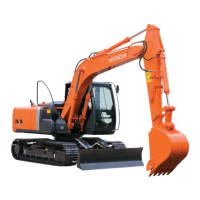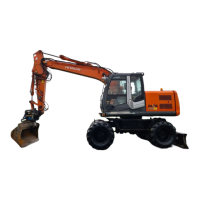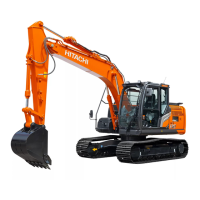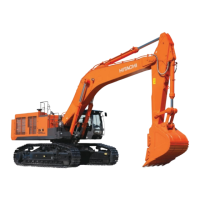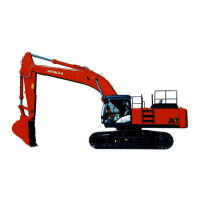Do you have a question about the Hitachi ZX 170W-3 and is the answer not in the manual?
Information for experienced technicians on how to maintain and repair the machine.
List of other relevant manuals and materials for reference.
Details the three main sections of the service manual: Technical Manuals and Workshop Manual.
Explanation of how page numbers are structured and what they indicate.
Explains safety alert symbols and signal words like CAUTION, IMPORTANT, and NOTE.
Details the SI units used in the manual and provides conversion tables.
Identifies safety alert symbols used on machines and in the manual.
Defines signal words like DANGER, WARNING, CAUTION, IMPORTANT, and NOTE.
Emphasizes reading and following safety signs and messages, proper maintenance, and authorized operation.
Guidance on preparing for emergencies like fires, including first aid kits and emergency numbers.
Recommends appropriate clothing and safety equipment for jobs.
Advises on protecting hearing from loud noise exposure.
Stresses daily walk-around inspections to prevent personal injury.
Provides safety guidelines for the operator's cab, including cleanliness and avoiding hazards.
Details safe practices for mounting and dismounting the machine.
Explains how to properly adjust the operator's seat for comfort and control.
Outlines critical safety steps before leaving the operator's seat.
Highlights the importance of seat belts for preventing injury during rollovers.
Provides guidelines for safe operation, including awareness of bystanders and working conditions.
Safety precautions for using starting fluid.
Instructs to always start the engine from the operator's seat.
Safety warnings and procedures for jump starting the engine.
Warns against carrying passengers due to safety risks.
General safety measures for operating the machine, including site investigation and protective clothing.
Emphasizes thorough job site investigation to prevent tipping and collapses.
Advises on using protective structures like ROPS and FOPS in hazardous areas.
Recommends using signals and a signal person for multi-machine operations.
Explains how to confirm the machine's direction relative to the operator's position.
Guidelines for safe driving, including avoiding obstructions and slopes.
Steps to prevent rollaways when parking or stopping the machine.
Safety measures to prevent accidents when backing up or swinging the upperstructure.
Instructions to keep people away from the machine's working radius.
Warning against placing the bucket over people or vehicle cabs.
Precautions for operating near cliffs and ensuring ground stability.
Detailed advice on preventing machine tipping, especially on grades.
Warning about the risks of bank collapse and landslide.
Safety measures for digging to avoid underground utilities and potential explosions.
Precautions for operating near overhead obstacles.
Safety guidelines for operating near electric power lines.
Procedure to follow during electrical storms.
Safety instructions for lifting and handling loads.
Measures to protect against flying debris, including wearing eye protection.
Steps for safely parking the machine.
Precautions for handling flammable fluids like fuel to prevent fires.
Guidelines for safely loading and unloading the machine onto trucks or trailers.
General safety procedures and precautions before starting maintenance work.
Instructions for using 'Do Not Operate' tags during maintenance.
Safety measures for supporting the machine during work.
Warnings about entanglement with moving machine parts.
Safety advice regarding pressure release on parts like travel reduction gears.
Guidelines for safely storing attachments to prevent falling.
Safety precautions for tire and rim maintenance, including inflation.
Precautions to avoid burns from hot fluids, steam, or hot surfaces.
Importance of periodic replacement of rubber hoses to prevent failures.
Hazards of high-pressure fluids and how to avoid them.
Checks and precautions to prevent fires related to oil leaks, electrical shorts, and flammables.
Procedure for evacuating the machine in case of a fire.
Warnings about the dangers of engine exhaust fumes and ventilation requirements.
Safety measures for welding and grinding operations.
Warnings about heating near pressurized fluid lines.
Precautions when welding or cutting lines with flammable fluids.
Safety advice for removing paint before welding or heating.
Hazards of asbestos dust and precautions for handling.
Safety measures to prevent battery explosions.
Safety precautions for servicing the air conditioning system.
Information on handling chemical products and MSDS.
Guidelines for proper disposal of hazardous waste.
Final checks before returning the machine after service.
| Brand | Hitachi |
|---|---|
| Model | ZX 170W-3 |
| Category | Excavators |
| Language | English |

